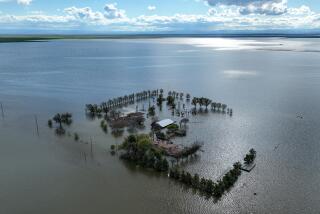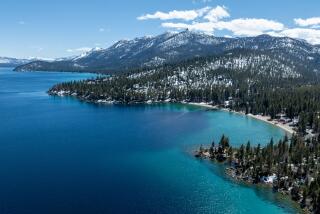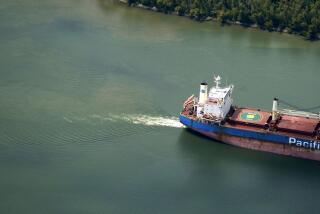Shoreline Eroding, Piers and Breakwaters Submerged : Great Lakes’ Rising Levels Stir Concern
CHICAGO — As record-breaking autumn rains across the upper Midwest send the Great Lakes to their highest levels in modern times, scientists are suggesting that in coming years the lakes may return to historic high-water marks, threatening shorelines from Chicago to Buffalo.
“We’re making history,” said Malcolm Todd, a Great Lakes expert with the Army Corps of Engineers.
In September alone, more than six inches was added to the depth of Lake Michigan and Lake Huron, essentially one giant body of water joined by the Straits of Mackinac. “That was higher than the record of this century,” Todd added. Lake Michigan, at its deepest, was 581.62 feet. Record depths for the year were also reached on Lake Erie and Lake St. Clair, a small body of water connected to the Great Lakes chain.
There is particular concern over the increasing water levels because the lakes are becoming deeper at a time when they normally should be losing depth and because late autumn and early winter storms on the lakes are usually the fiercest of the year, raising the potential for serious damage to shorelines.
Worst Month for Storms
“November is historically the worst month of the year for storms on the Great Lakes and . . . even an extra inch of water can translate into quite a bit of additional energy when it comes to heavy storms and winds,” said Michael J. Donahue, research director for the Center for the Great Lakes.
“It could be of distastrous proportions if we get a major storm, as we traditionally do in late fall,” Todd said.
“It’s probably the most critical period in terms of potential for damage that the Great Lakes have had, at least in this century,” said Frank Quinn, chief hydrologist for the Greak Lakes Environmental Research Laboratory in Ann Arbor, Mich.
Beyond the seasonal concerns, there is mounting evidence that eight states and one Canadian province bordering the lakes will lose significant segments of their shorelines. Beaches have already all but disappeared in parts of Illinois, Michigan and Wisconsin. High-rise apartments along Chicago’s North Shore have experienced some flooding, and Lake Shore Drive is often battered by waves during storms, something that was a rarity only a few years ago.
Piers Submerged
Piers and breakwaters have disappeared under water all around lakes Michigan, Huron and Erie and the smaller Lake St. Clair.
Curtis Larsen, a geologist with the U.S. Geological Survey, believes the Great Lakes may be returning to water levels not seen since at least 1850, before regular records were kept.
Larsen, who studied shoreline features, beaches and marshes along Lake Michigan, said the lakes have been at a low-water mark almost since the first settlers moved into the region.
“If we use records of the geologic past, it would seem that everything that we have recorded so far in this century has been a low (water) period. . . . We’re simply returning to normal now,” he said.
Predictions for wetter and cooler weather in the Great Lakes region accompany the projections for increasing lake levels. “We’re in a climate that has over the last 10 years appeared unusually cold and wet,” said Charles W. Shabica, a geologist at Northeastern Illinois University. “This freaky storm we’ve had for the last couple of weeks . . . may be a portent of things to come.”
More to Read
Sign up for Essential California
The most important California stories and recommendations in your inbox every morning.
You may occasionally receive promotional content from the Los Angeles Times.










